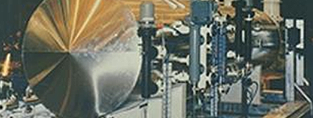
- (03) 5909 8218
- enquiry@fusionweld.com.au
Pressure Vessel Design and How It Affects Accuracy in Performance
April 13, 2016

Comprehensively compiled engineering charts and complex structural integrity equations blend material design with mechanical aptitude to create high performing vessels. Indeed, a slew of theoretical and practical engineering domains are employed in this demanding circumstance. A library of collected resources, including shell thickness charts, assumed and unknown stress variables, and a selective series of modeled designs aid in creating these conceptual forms, at which point spherical shell transition is translated against a straight-lined cylinder to fabricate entirely safe storage units.
Pressure vessel design, as illustrated in the above paragraph, is realized in the concept stage. An engineer's unwavering finger selects appropriate wall thicknesses and capacity requirements as set by inherent stress requirements and governmental guidelines. Tangential stress and radial pressure spikes are accommodated by matching material characteristics against joint efficiency ratios, which again returns the discerning eye of the engineer back to load charts and stress analysis equations. The result is a symmetrical shell and shell lining built from optimal alloys, a vessel that is workable, rollable, and weldable so as to ensure the uniformly fabricated metal is sealed against pressure-induced leaks. In short, the design adheres to mathematically exhausting guidelines, but the goal is always to ensure uniform distribution of the pressurized fluid so as to sidestep material-weakening pressure traps, spots where weld seams could fail or material flaws could become problematic.
Performance-rated productivity margins and safety-related codes prosper when such pressure vessel design requirements are met and exceeded. For example, transient flow ratios receive greater consideration. The fuel or chemical compound can be pressurized more efficiently, and general performance standards are magnified as all possible stress factors are accounted for across every weld joint and cylindrical seam. Of course, stress analysis may be one of the more important factors in the design, but it's not the only element within the statistical analysis zone. For example, the thin or thick-walled design protects against stress, yes, but it also keeps the vessel light and compact, which represents an important part of the external geometry equations. Not that there's a mathematical science with the same degree of complexity as the internal mathematics, but still, the pressure rating of the vessel does relate inversely to capacity, meaning a thicker container will result in a smaller profile, an intelligently sized vessel that fits the client's projected installation space.
The pressure vessel design process employs volumes of parametric data and engineering charts, materials and workshop techniques, all with a view to fabricating a high performing pressure vessel that satisfies rigorous customer requirements.
Contact Details
Fusion - Weld Engineering Pty Ltd
ABN 98 068 987619
1865 Frankston Flinders Road,
Hastings, VIC 3915
Ph: (03) 5909 8218
Optimized by NetwizardSEO.com.au
Recent Posts
- Compressed Hydrogen Storage Vessels: Material Selection, Design & Australian Standards
- Welding QA/QC in Oil & Gas Pressure Vessel Fabrication – Ensuring Code Compliance
- AS1210 vs ASME VIII Pressure Vessel Code: Key Differences for Australian Projects
- Mitigating Hydrogen-Induced Cracking in Pressure Vessels: Engineering and Material Strategies
- Storage Tank Solutions Australia: Field-Erected, Prefabricated & Self-Bunded Explained
- Reducing Environmental Risks: Self-Bunded Tanks in Australian Oil & Gas Operations
- Precision in Production: How Pressure Vessels Are Manufactured for Industrial Safety
- Shell & Tube Heat Exchangers: Improve Thermal Control & Energy Recovery in Petrochemical & Pharmaceutical Plants
- In-Service Inspection for Compressed Air Receivers for Power Plant Shutdown Prevention
- Power Plant Pipe Spooling Fabrication – Get Rapid, Code-Compliant Spools Ready for Installation
- Field Erected Tanks: Safe, Reliable On-Site Fuel Storage Solutions in Australia
- Custom Pressure Vessel Fabrication for Flammable Gases
Posts 2025
- Compressed Hydrogen Storage Vessels: Material Selection, Design & Australian Standards
- Welding QA/QC in Oil & Gas Pressure Vessel Fabrication – Ensuring Code Compliance
- View all articles…
Posts 2024
- Large Process Vessels: Optimising the Design for Maximum Efficiency [2025]
- Pressure Equipment Management System Installation: Detect Equipment Faults Early
- View all articles…
Posts 2023
- Pressure Piping System Inspection: A Gift of Safety for the Holidays
- Deaerator Inspections by Fusion-Weld Engineering and How They Reduce System Downtime
- View all articles…
Posts 2022
- How Fusion Weld Keeps Up With AS-NZS ISO 9001:2008 Standard
- Boiler Equipment Safety Inspection During the Summer Season
- View all articles…
Posts 2021
- Avoid These Factors and Practices that Contribute to Sealing Damage in Pressure Vessels
- Do's And Don'ts Of Industrial Boiler Inspection And Maintenance From Fusion-Weld
- View all articles…
Posts 2020
- What are the Risks and Hazards Involved in Pressure Vessel Equipment?
- How to Know if Your Pressure Equipment Needs Repair or Replacement?
- View all articles…
Posts 2019
- Factors that Contribute to Pressure Vessel Failure
- Pressure Vessel Regulations in Australia: What are the Mandatory Requirements?
- View all articles…
Posts 2018
- Pros and Cons of Spherical vs. Cylindrical Pressure Vessels
- What are the Different Hazard Levels in Pressure Vessels?
- View all articles…
Posts 2017
- Transportable Pressure Vessels: The Importance of Inspection and Safety Checks
- Fracture Mechanics and Stress Analysis of Cracks in Pressure Vessels
- View all articles…
Posts 2016
Posts 2015
- What Are Deaerators & Feedwater Vessels?
- Precautions and Safety for Compressed Air Receiver Vessels
- View all articles…
Posts 2014
- Demonstrating In-process Inspection Procedures
- Static Grounding Practices and Standards
- View all articles…